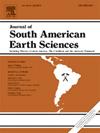Coastal dynamics: Assessing erosion and progradation patterns in Campeche coastal region using machine learning techniques for geological insights
IF 1.7
4区 地球科学
Q3 GEOSCIENCES, MULTIDISCIPLINARY
引用次数: 0
Abstract
This study examines shoreline dynamics along the Campeche coastal region from 1974 to 2024, using machine learning techniques to analyse long-term trends in erosion and accretion. Integration of machine learning with geological analysis enables precise evaluation of shoreline changes, enhancing the understanding of coastal dynamics. Spanning 50 years, the research utilizes satellite imagery, historical maps, remote sensing, and GIS to assess shoreline changes and their geological significance. Results show that 93% of the coastline is experiencing accretion, while 7% is undergoing erosion. Accretion rates range from a minimum of 2.36 m (0.05 m/year) to a maximum of 1136.61 m (22.73 m/year), while erosion rates vary from −2.56 m (−0.05 m/year) to −131.41 m (−2.63 m/year). This study identifies key coastal changes, with Zona Centra and Koben regions experiencing significant accretion, while South San Lorenzo faces the highest erosion activity. Understanding these dynamics is crucial for coastal management and mitigation strategies. Campeche's coastline predominantly features carbonate-rich sediment deposits, influenced by ocean currents, sediment supply, and coastal morphology, resulting in widespread accretion. Localized erosion hotspots are linked to human activities and disruptions in sediment transport. Machine learning models identified spatial patterns and quantified the influence of stratigraphy on shoreline changes, highlighting the benefits of combining modern techniques with traditional methods for accurate coastal analysis. Campeche's rich geological diversity and extensive data availability make it an ideal case study for exploring machine learning applications in coastal management and assessing coastal vulnerability. This comprehensive approach offers valuable insights for sustainable development and addressing coastal erosion challenges.
求助全文
约1分钟内获得全文
求助全文
来源期刊

Journal of South American Earth Sciences
地学-地球科学综合
CiteScore
3.70
自引率
22.20%
发文量
364
审稿时长
6-12 weeks
期刊介绍:
Papers must have a regional appeal and should present work of more than local significance. Research papers dealing with the regional geology of South American cratons and mobile belts, within the following research fields:
-Economic geology, metallogenesis and hydrocarbon genesis and reservoirs.
-Geophysics, geochemistry, volcanology, igneous and metamorphic petrology.
-Tectonics, neo- and seismotectonics and geodynamic modeling.
-Geomorphology, geological hazards, environmental geology, climate change in America and Antarctica, and soil research.
-Stratigraphy, sedimentology, structure and basin evolution.
-Paleontology, paleoecology, paleoclimatology and Quaternary geology.
New developments in already established regional projects and new initiatives dealing with the geology of the continent will be summarized and presented on a regular basis. Short notes, discussions, book reviews and conference and workshop reports will also be included when relevant.
 求助内容:
求助内容: 应助结果提醒方式:
应助结果提醒方式:


